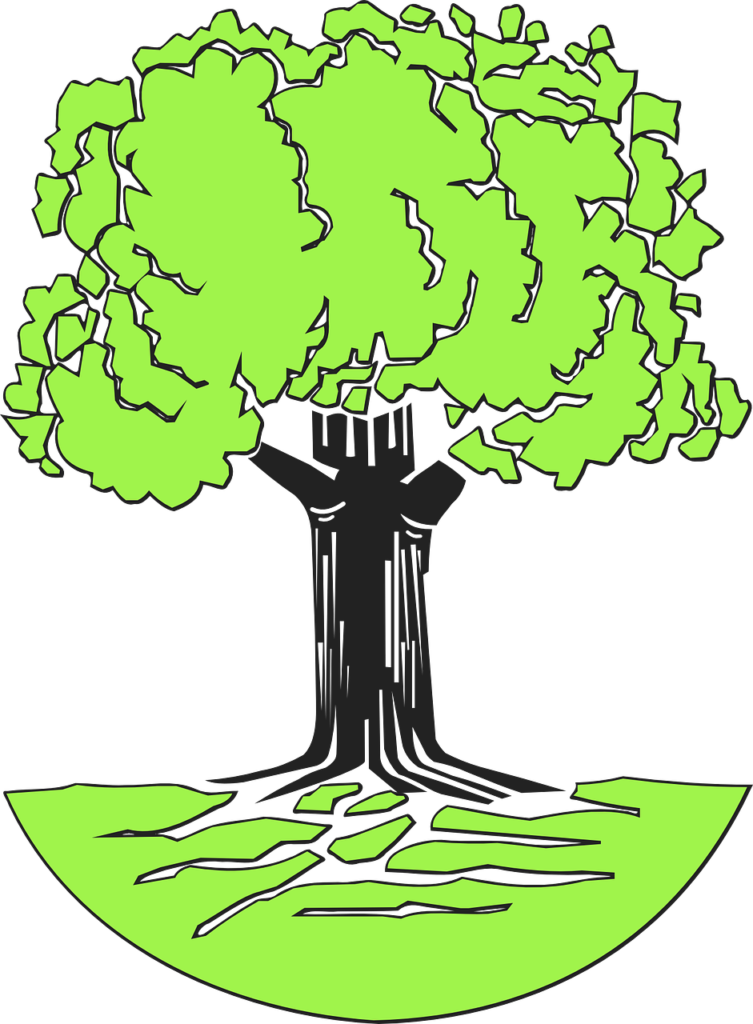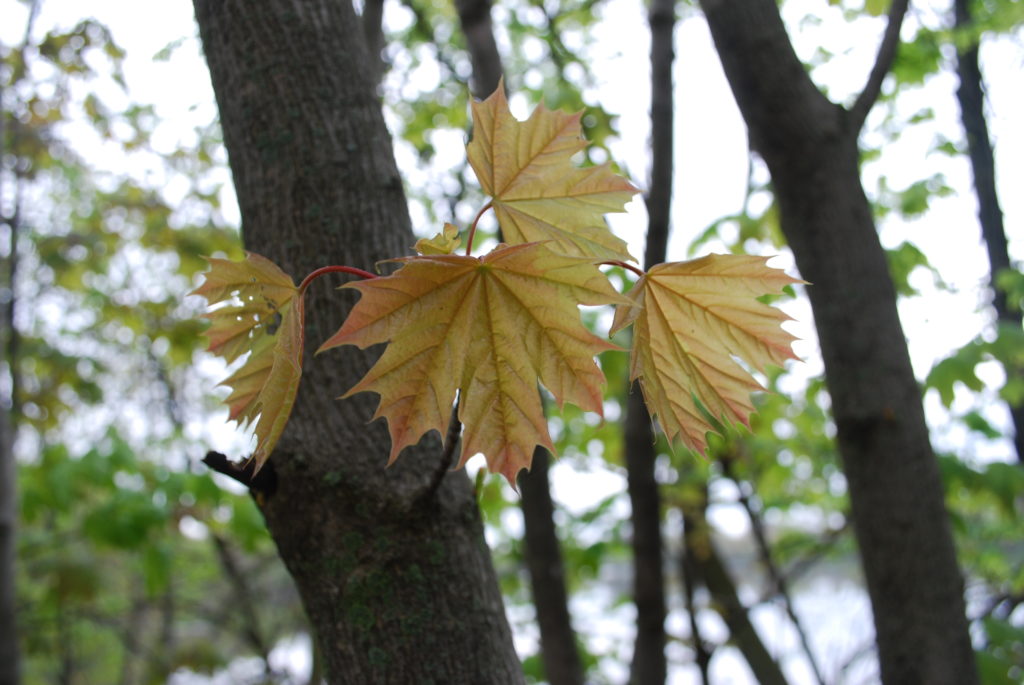If 2017 is as Bad as 2016 . . .
by Jeremy Marin
We’ve just come through a very rainy April, but the summer of 2016 was one of the driest in recent memory. With global warming, the same conditions can occur again. If the summer of 2017 is dry, here’s how to take care of your trees.
Just like there’s no single best tree for all yards, there’s no single best way to irrigate trees during periods of drought. The easiest and most effective options for one family will be difficult, frustrating, or impossible for others.

A tree’s roots extend to the drip line, the horizontal reach of its branches. The whole area inside that approximate circle is where you should water. Pixabay Stock image.
Not all trees have the same water needs or preferences either, so it is worth taking a few minutes to look online for information about the water requirements and drought tolerance of your trees, and writing the information down for future easy reference.
Before doing any watering or spending any money, learn how to check if your tree needs water. Using a shovel, screwdriver, or whatever sharp, pointy item you’ve got, jab it into the soil within the drip zone (the outer edges of the branches) of the tree to a depth of six to eight inches. If it comes out with dry and crumbly soil, it is time to water, preferably with a slow soak. If moist pieces of soil come up with the screwdriver, you can hold off watering. If you water, make sure to water slowly, so the water can seep into the soil, and not at the base of the tree where fine roots are limited. Your tree’s roots expand to the drip line, so if watering is necessary, water as much of that area as possible. If your tree is a variety that needs more water, and rain isn’t in the forecast, here are some options that often make good sense in suburban Massachusetts, where population density means that trees aren’t all that far from the house.
Greywater Systems
The average home in Belmont uses 77 gallons of water per person daily; compare with usage from other Massachusetts towns at http://archive.boston.com/yourtown/specials/water/massachusetts_water_usage_map/.
If treated, some of that water can be used on trees and shrubs. Greywater systems will collect water from your clothes and dishwashers, showers and sinks, but not your toilets (considered “black water”), and purify it enough for gardening, but not for drinking or bathing.
Having a professional greywater system installed is a wonderful, long-term, but expensive option. Massachusetts (as most states) has greywater regulations that typically require pumps, carbon filtration systems, and some significant new piping in the home. If you have lots of outdoor watering needs, greywater systems may provide a reasonable return on investment, but for most people, the return isn’t there. (The hope is that this will change, as systems improve and costs come down.)
Let’s look at some more reasonably priced and free options, instead.
Mulch, Mulch, Mulch
Mulch is the first and most important step in reducing water use for irrigation.
Try this experiment: Place two wet paper towels in your yard on a warm, sunny day. Leave one open to the elements (place a rock on it so it doesn’t blow away), cover the other with mulch, and then guess which one will dry out first. If your soil isn’t covered with mulch, it is going to dry out faster, just like that uncovered paper towel.
Using an organic mulch (preferably arborists’ chips or shredded leaves, but never bark mulch), will help keep the soil moist longer, as well as provide other benefits to the soil. Be sure to leave a few inches of space around the base of the tree mulch free, and go out as far as you can within the drip zone of the tree. Adding two to six inches is a great way to help protect the soil and retain moisture.
Using an organic mulch (preferably arborists’ chips or shredded leaves, but never bark mulch), will help keep the soil moist longer, as well as provide other benefits to the soil.
Rain Barrels and “Warm up” Water
Rain barrels are perhaps the most familiar option to save water, but without rain they often become lawn sculptures. Drought means no rain, and the barrels don’t fill themselves.
It doesn’t have to be that way, even if there is a drought. You can be filling the rain barrel daily with perfectly usable “waste” water. Holding the water in the rain barrel until needed is easy, and allows you can hook a hose from there to drip irrigation or your preferred watering method, as needed. The kitchen provides a great opportunity to collect water that can be repurposed for your trees and shrubs.
• Pour pasta, bean, and other cooking water into a container in your sink, rather than down the drain. When you’re ready (and after the water has cooled), bring it outside to your tree. In some cases, especially if you’re boiling/pressure cooking dried beans, the water will have valuable proteins that will fertilize your soil.
• Wash your produce, hands, and dishes over a bucket in the sink to capture the water. With any soapy water, you need to exercise some caution. First, food residue can attract bugs or critters, so try to limit residue or filter it out. Also, soapy water contains sodium which can damage grass and other plants if sprayed on their leaves, so this is best used in mulched areas. (You can wet hands over the bucket but rinse the soap into the sink, avoiding the problem.)
If your shower, bath, or faucet takes a while to warm up, then capturing that cold water may be a good option.
• If your shower, bath, or faucet takes a while to warm up, then capturing that cold water may be a good option. The obvious advantage is that the water is exactly the same as what comes out of the spigot. The difficulty for many is how to capture and then transport that water to where it is needed. (See “Rob Peter to Pay Paul” below.)
• Dehumidifier water, air conditioner condensate, and similar opportunities vary from home to home. Look around and see what you can use.
Another option is to empty the warm up water into one big container, such as a rain barrel. This will allow you to collect a bunch of water in one spot and use it as necessary. Just be careful about which types of water you’re saving and for how long. You don’t want a bunch of food-tainted water sitting in a rain barrel for any length of time, where it can smell and breed harmful bacteria.
If hauling water from the bathroom shower to the rain barrel or tree outside doesn’t fit your preferences, keep a container in the bathroom.
Rob Peter to Pay Paul
If hauling water from the bathroom shower to the rain barrel or tree outside doesn’t fit your preferences, keep a container in the bathroom.
Your toilet probably uses anywhere from 1.6 to 5 gallons per flush. Capture that warm up water and use it to flush your toilet. This water from the shower can be poured into the tank or directly in the bowl. If you’re capturing sink water as you wash your hands, that should only go in the bowl.
Pouring water in the toilet obviously isn’t watering your trees or shrubs, but it is offsetting the water you may be using outdoors, making it a great practice for anyone capable of doing it.
Drip Irrigation
Drip irrigation for trees can take a few different forms and can vary in price from free to, well . . . not free.
On the free end, you can ask for a five-gallon bucket from your favorite restaurant, poke or drill one or more 1/8” holes in the side near the bottom, and fill it with water. You can set up several buckets around the yard or just move one around. Or try overturned two-liter bottles that you fill individually or large 18-gallon totes or any other container. You can even paint them for a better aesthetic.
Among the paid options, your wallet is your guide. You can get a simple length of drip line or soaker hose for an as-needed watering, allowing you to remove the whole thing when it isn’t needed. Or you can install an in-ground system. (Studies I’ve seen show that in-ground systems, which are the most expensive option, routinely waste lots of water and money.)
Another potential compromise is a semi-permanent above-ground system, such as those widely available online and at big box hardware stores. These DIY systems are easy to assemble with little more than clippers, and can be hooked into a spigot timer that allows you to water at set times.
Tips for Grass and Shrubs Too
All of these recommendations apply equally to trees, shrubs, and flower gardens. Options for the lawn are basically three:
1. Let the grass go dormant, where it will turn brown but not die.
2. Plant drought-tolerant grasses.
3. Collect excess water (as in the article) in a rain barrel or similar vessel, then use an electric pump to force water out a hose to spray by hand or through a sprinkler.
Jeremy Marin is an Arlington resident who spends his time tending his own garden and helping others in person and on his website: http://www.arlingtonheet.org.



Sorry, the comment form is closed at this time.